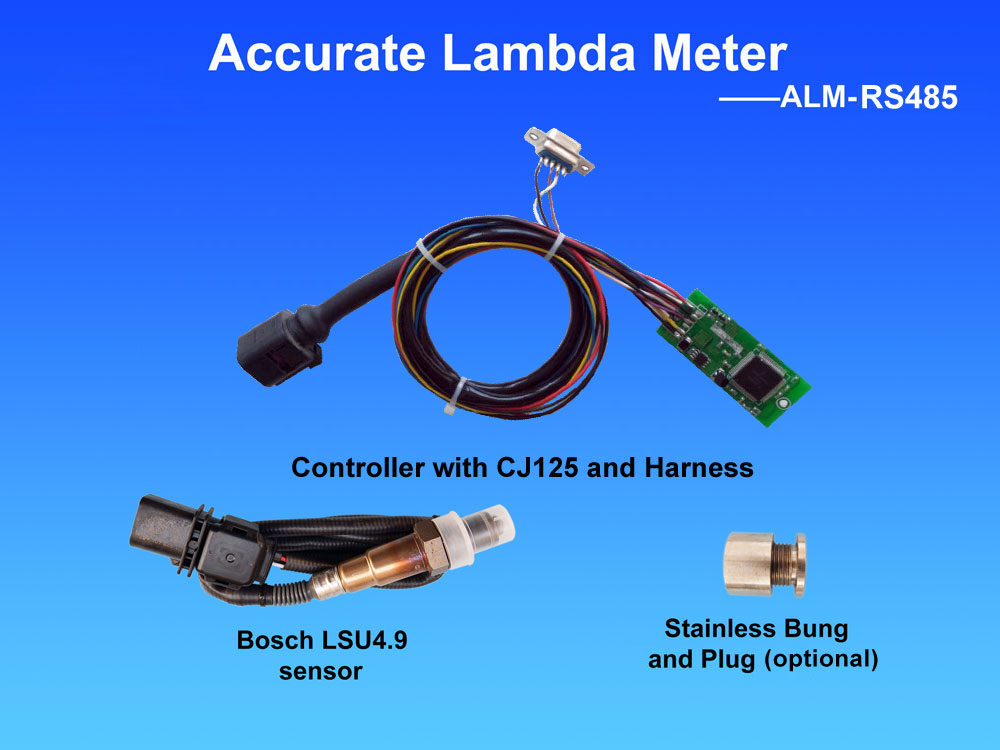 ALM-RS485 (Accurate Lambda Meter in a mini board)
ALM-RS485 (Accurate Lambda Meter in a mini board)
ALM-RS485 is an Accurate Lambda Meter that supports RS485 communication with ModBus protocol, which is more suitable for most industrial control applications than other models and can be integrated with other devices via standard RS485 protocol. ALM-RS485 default is ALM-Board type, you can also customize other models, such as ALM-LED, ALM-Gauge, please contact us by email to info@ecotrons.com. ALM (Accurate Lambda Meter) is an air-fuel-ratio (AFR) meter which uses the Bosch LSU4.9 wideband oxygen sensor and Bosch semiconductor chip CJ125 to accurately measure the AFR or lambda for variant combustion engines. Click here, if you want to know immediately "What set ALM apart from other wideband controllers?" ALM-Board is a mini-version of ALM that trims off the non-core parts and keeps the minimum set of electronics, yet providing the core function of the wideband controller. It is a mini board in size of 2.5"x1"x0.5", and it can be plugged in to the main ECU board easily. ALM-Board has the full control function for a LSU 4.9 sensor. Same as our other ALMs, it has a CJ125 chip built-in. It measures the O2 concentration accurately, and converts it to either lambda, or AFR, as you want. It controls the sensor temperature in a close loop mode, accurately at 780 C degrees. ALM-board is designed to fit into the OEM's controller with a very small foot print. It has its own LSU4.9 sensor connector and cable. It can be connected to the main board via a mini 6-pin connector. Or you can request a customer connection between the ALM-Board to your main board. We do customization for small manufacturers. Again, all our ALMs have the high accuracy and fast response characteristics, which are the root of our design at the very beginning. First, ALM uses the more advanced LSU4.9 sensor instead of a LSU4.2 which is still used by most other wideband controllers. LSU4.9 is the new generation wideband sensor. It is superior to LSU4.2. One obvious proof is: Bosch uses LSU4.9 across the board for their wideband applications. (See the appendix: LSU4.2 vs LSU4.9) Click here to see why LSU 4.9 is superior to 4.2 Second, Bosch chip CJ125 is the integrated chip (IC) specifically designed for LSU 4.9/4.2 Sensors. Bosch's own wideband controller, "LambdaTronic", uses CJ125 driver chip. In fact, Bosch uses this chip wherever a LSU sensor is used. The CJ125 and LSU sensor are mated-pair by Bosch. Presumably LSU sensors work the best with CJ125 chips. Click here for Bosch LT4 wideband controller info Together, LSU 4.9 and CJ125 make our ALM a more accurate lambda meter in the market.
Click here to see a successful story of an OEM multi-fuel engine application
Click here for some news on customer applications
List of ALM-Board parts
Small ALM board 2.5"x1"
6-pin mini plug to the main board (optional)
Sensor Harness (1.5 meter default, 3 meter optional)
Bosch LSU 4.9 sensor
Stainless plug and bung (included if you buy the sensor)
RS485 communication with ModBus protocol
documents and ALM GUI software (downloadable)
ALM-Board technical specifications
Power supply
Input voltage range: only DC12V
Controller current: typical 50mA for the board; the heater current is separate from 12V supply
Sensors
Compatible: LSU4.9 (LSU 4.2 capable but not recommended)
Number of Sensors: One
Accuracy
Lambda range: λ = 0.55 ~ ∞ (Gasoline AFR: 8.08 to free air)
Lambda accuracy: ±0.008 @ λ=1.00
±0.01 @ λ=0.80
±0.05 @ λ=1.70
Air/Fuel Ratio: Fuel dependent (see lambda range and accuracy)
Free air calibration: No need (it measures the free air)
Response time
5ms updating rate (everything finished in 5ms)
Heater
Control built-in PID control with CJ125
Current Typical 1A; Max 1.7A
Heater return (H-) Separate wire from Ground
Communications
RS485 only
ALM broadcasts: O2%, Lambda, Sensor temperature, heating duty cycle, and sensor error code
Main-Processor
CPU: FreeScale 16-bit micro-processor S12P (auto industry rated)
Speed: 32MHz
Memory: 128k Flash, 6k Ram, 4k Data
Special features
On-Board-Diagnosis and error report
Self-learning of part-to-part variations, aging effect
Working with different types of fuels (gasoline, diesel, E85, etc)
General
Temperature range: -40C ~ +110 C (can be installed in the engine compartment)
Dimensions: 2.5" x 1" x 0.5"
 ALM Board RS485 Manual
ALM Board RS485 Manual 
 ALM Serial Communication Protocol - SCI / RS232 / RS485 - v1.6
ALM Serial Communication Protocol - SCI / RS232 / RS485 - v1.6
 ALM assistant for Modbus user manual
ALM assistant for Modbus user manual software
software ALM assistant for Modbus v1.2
ALM assistant for Modbus v1.2
| Characteristics | LSU4.2 | LSU4.9 | Notes |
| lambda range | lambda = 0.65 ~ ∞ | lambda = 0.65 ~ ∞ | |
| Accuracy | only good at lambda = 1 or moderate rich |
accurate at both rich and lean, wider range |
LSU4.2 is only accuracy at lambda ≈1 and moderate rich, between 0.8~1.0 lambda; LSU4.9 has better accuracy in both rich and lean conditions, suitable for gasoline, diesel, CNG, etc. |
| Response time | Slower | Faster | Thinner sensing element of LSU 4.9 makes it more responsive to the AFR change, dynamically more accurate, and easier to light off, less heating power needed. |
| Heating power | 10W | 7.5W | LSU4.2 has the off-centered-heater vs. LSU 4.9 has the centered-heater in the laminate; LSU4.9 has better heating efficiency, less heating power needed. |
| Free air calibrations |
needed | not needed | LSU4.2 is susceptible to reference air contaminations, which is called CSD (characteristic shift down), requires frequent free-air calibrations. LSU4.9 uses reference pump current instead of reference air. No more CSD. No requirement of free-air calibrations |
| Nernst cell resistance vs. temperature |
80~750C | 30~790C | LSU4.9 has higher resolution of internal resistance vs. temperature characteristics, which makes the temperature measurement more accurate, and better heater control, therefore higher accuracy of lambda. |
| Light off time | long | short | LSU4.9 lights off faster. Lambda controls can be active much faster during warm up phase. |
| Reliability | Improved reliability | LSU4.9 is superior to LSU4.2 with regard to the reliability and life. | |
| Check with Bosch | Still selling it | Recommended | Bosch recommends LSU4.9 to all OEMs. Bosch uses LSU4.9 for its own wideband controller. http://www.bosch-motorsport.de/media/catalog_resources/Lambdatronic_LT4_Datasheet_51_en_2785631627pdf.pdf |







